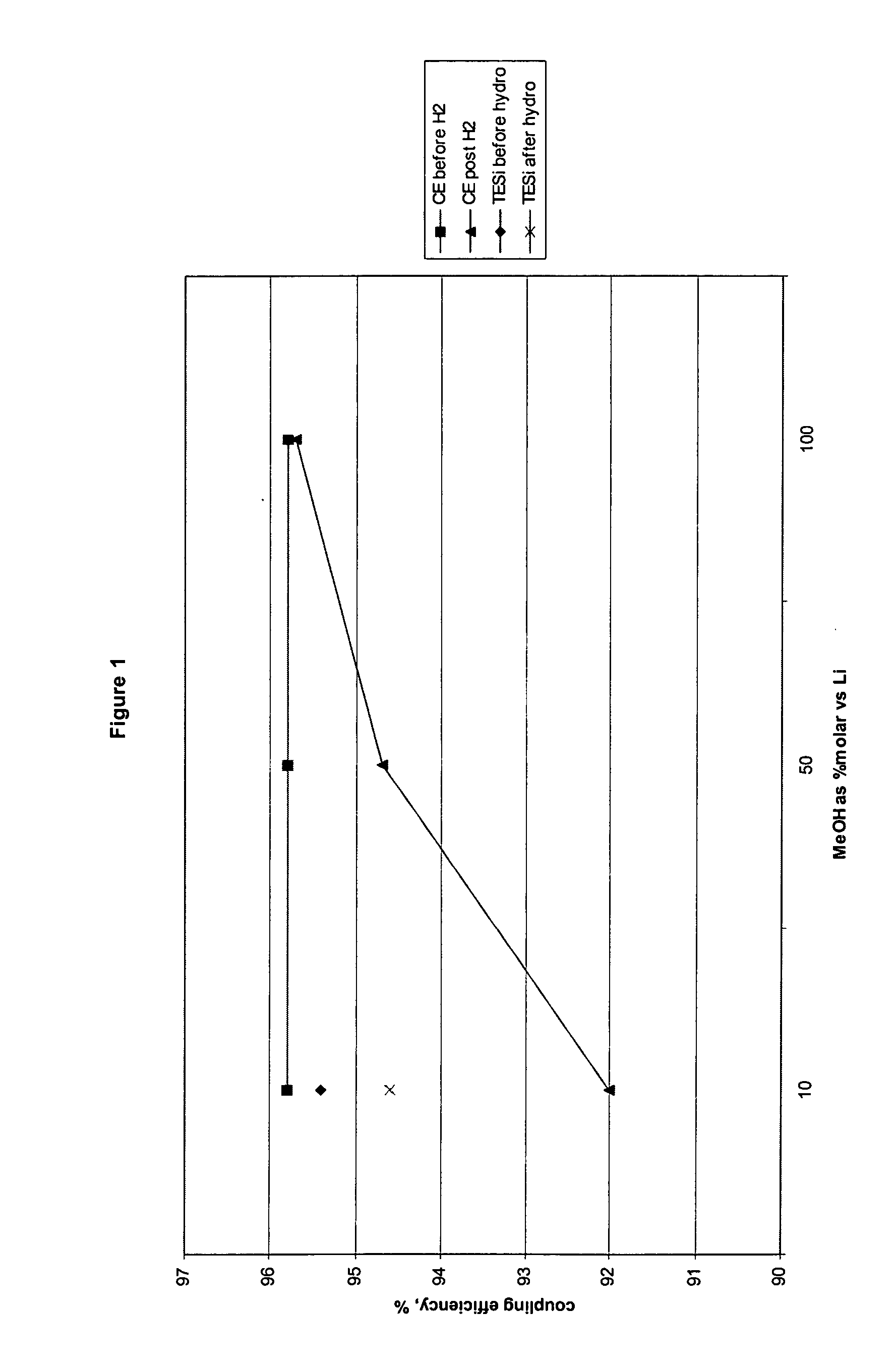Process for preparing block copolymer and resulting composition
a technology of anionic polymer and copolymer, which is applied in the direction of film/foil adhesives, adhesives, etc., can solve the problems of s-e/b-s polymers for use in highly oiled compounds, the tensile strength and related properties of triblock copolymers cannot be sacrificed in this area, and the contamination of diblocks can greatly reduce the tensile strength and related properties of triblock copolymers or compounds, etc. oxidation
- Summary
- Abstract
- Description
- Claims
- Application Information
AI Technical Summary
Benefits of technology
Problems solved by technology
Method used
Image
Examples
example 1
[0055] A diblock polymer anion, S—B—Li, is prepared as follows (Experiment 7774): 96 kg cyclohexane and 24 kg styrene are charged to a reactor, followed by 590 milliliters of a sec-butyl lithium solution (12%wt BuLi, 0.86 mol). A second reactor is charged with 264 kg cyclohexane, 25 kg diethyl ether and 20.2 kg butadiene. Following titration to remove impurities, 95 kg of polystyryllithium solution prepared in the first reactor is transferred to the second reactor. After polymerization has commenced, an additional 20.3 kg of butadiene is added, at a rate sufficient to keep the temperature around 55° C. After about 98% conversion ofthe butadiene, 45 grams oftetramethoxy silane (“TMSi”) is added (TMSi:PLi about 0.45). The final product consists of an almost 50:50 mixture of 2-arm (linear) and 3-arm polymer, with an overall coupling efficiency (all coupled products / coupled products+un-coupled diblock) of 95.3% as measured by a Gel Permeation Chromatography (GPC) method. Before coupling...
example 2
[0066] A diblock polymer anion, S—B—Li, is prepared as follows (run 7852D): 60 kg cyclohexane and 15 kg styrene are charged to a reactor, followed by 400 milliliters of sec-butyl lithium. A second reactor is charged with 155.4 kg cyclohexane, 15 kg diethyl ether and 23.8 kg butadiene. Following titration to remove impurities, 56 kg of polystyryllithium solution prepared in the first reactor is transferred to the second reactor. After about 98% conversion of the butadiene, 26.3 grams of tetramethoxy silane (“TMSi”) is added (TMSi:PLi about 0.45). The final product consists of 41% 2-arm (linear) and 53% 3-arm polymer, with an overall coupling efficiency (all coupled products / coupled products+un-coupled diblock) of about 96%. The styrene block has a molecular weight of 29,300 and the butadiene block has a molecular weight of 62,000.
[0067] The results of the following hydrogenation experiments are summarized in FIG. 1.
[0068] A sample of the polymer is hydrogenated with 100% methanol / L...
example 3
[0078] A series of laboratory screening experiments are executed to determine the effect of tetramethoxysilane (TMSi) to Li ratio on overall coupling efficiency and arm distribution.
[0079] Polybutadienyllithium of a nominal molecular weight of 2,500 is prepared as follows: 750 grams of cyclohexane, 60 grams of diethyl ether and 100 grams of butadiene are charged to a 1-liter Buchi glass autoclave. The reactor is heated to about 40° C. and about 21 grams of butyllithium solution is added. The reaction temperature is adjusted to about 50° C. and the reaction is allowed to proceed to about 99% conversion. In the first example, a solution of TMSi in cyclohexane is added at about 1.6 mL / min using a syringe pump. Enough TMSi is added to provide 0.5 moles TMSi per mole polymer-Li at the end of the program. Under these conditions, it is anticipated that the coupling reagent will react as fast as it is added, to give close to the maximum attainable coupling efficiency. The result (Table 7) ...
PUM
| Property | Measurement | Unit |
|---|---|---|
| molar ratio | aaaaa | aaaaa |
| temperature | aaaaa | aaaaa |
| molar ratio | aaaaa | aaaaa |
Abstract
Description
Claims
Application Information
 Login to View More
Login to View More - R&D
- Intellectual Property
- Life Sciences
- Materials
- Tech Scout
- Unparalleled Data Quality
- Higher Quality Content
- 60% Fewer Hallucinations
Browse by: Latest US Patents, China's latest patents, Technical Efficacy Thesaurus, Application Domain, Technology Topic, Popular Technical Reports.
© 2025 PatSnap. All rights reserved.Legal|Privacy policy|Modern Slavery Act Transparency Statement|Sitemap|About US| Contact US: help@patsnap.com

